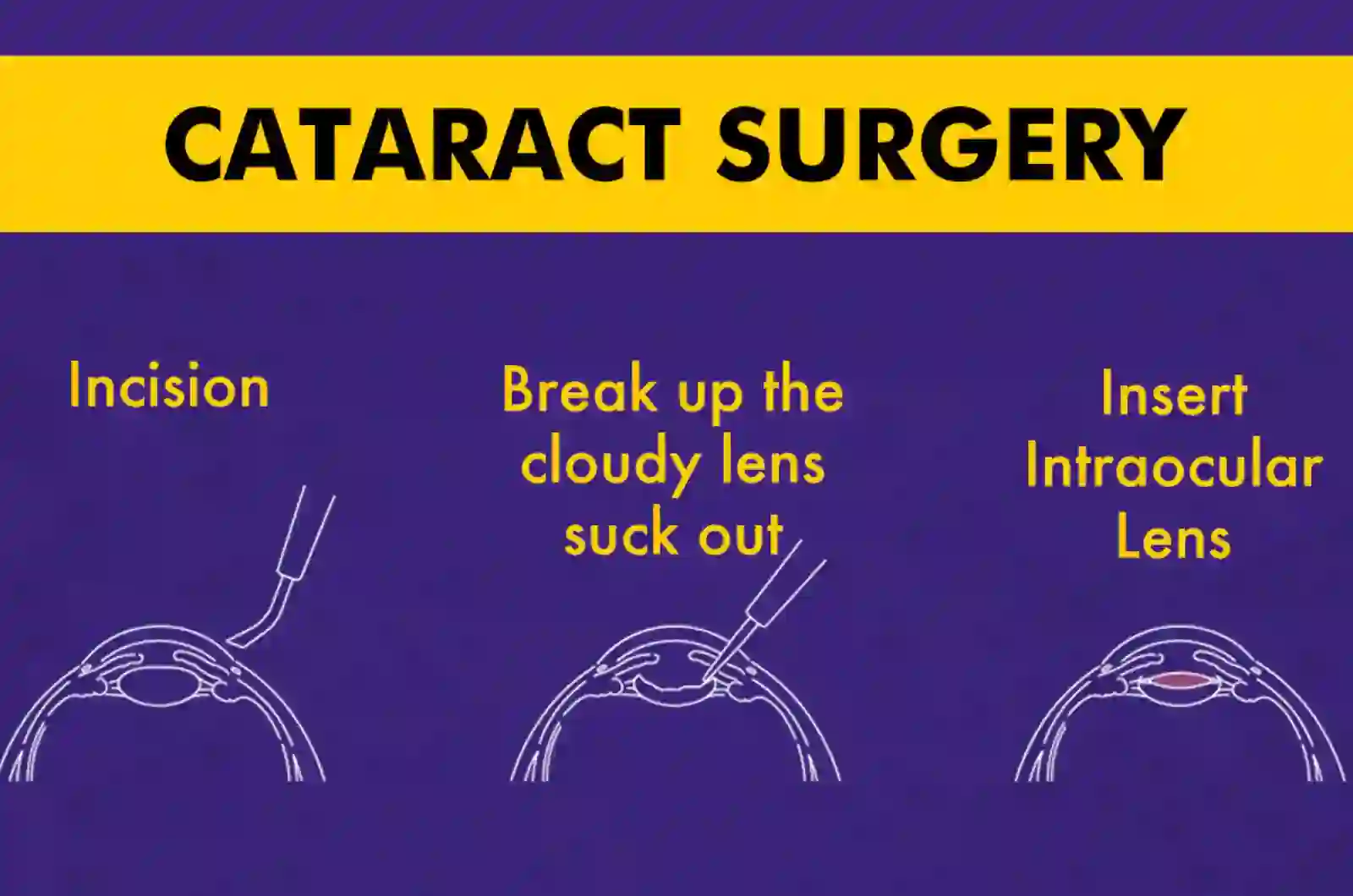|
Key Takeaways:
|
Cataracts occur when the eye’s natural lens becomes cloudy, leading to blurry vision, glare, and eventual vision loss if left untreated. Cataract surgery is a medical procedure that removes the cloudy lens and replaces it with an artificial intraocular lens (IOL) to restore clear vision. This surgery is widely performed and is considered the most effective treatment for cataracts.
There are 6 (six) different types of cataract surgery: namely, phacoemulsification (phaco), MICS, FLACS/laser-assisted cataract surgery, ECCE/SICS, and ICCE. Choosing the right approach can be confusing; people ask how many types of cataract surgery there are and what each type of cataract surgery actually means.
This guide explains the main types of cataract surgery in India, including how each is performed, who it suits, recovery time, and risks so that you can decide wisely with your doctor.
Different Types of Cataract Surgery
The different types of cataract surgery in India are phaco, MICS, SICS/ECCE, and laser-assisted methods. Below are the 6 (six) different types of cataract surgery:
|
Cataract surgery name |
Incision (about) |
Who does it suit? |
Average Recovery |
|
Phacoemulsification (Phaco) |
2–3 mm clear corneal, self-sealing |
Most age-related cataracts, patients wanting a tiny cut and quick return to work, may not suit very hard/brunescent lenses in some cases |
Clearer in 24–48 hrs; light work in 2–3 days (if advised); full heal in 3–4 weeks |
|
MICS (Micro-Incision Cataract Surgery) |
1.8–2.2 mm, self-sealing |
Routine cataracts where low SIA and tiny wounds are desired |
Vision improves in 1–2 days; stabilization over 3–4 weeks (routine cases) |
|
Femtosecond Laser-Assisted (FLACS) |
2–3 mm; laser makes key steps, then phaco |
Patients choosing premium IOLs (toric/multifocal) who want precise capsulotomy/centring, comfortable with the extra cost |
Similar to phaco: clearer in 1–2 days; full healing in 3–4 weeks |
|
Small Incision Cataract Surgery (SICS) |
~5.5–6.5 mm self-sealing tunnel |
Dense/brown cataracts; cost-friendly option; centres without phaco machines |
Vision improves in a few days; full healing in 3–4 weeks |
|
Extracapsular Cataract Extraction (ECCE) |
9–12 mm with sutures |
Very hard/mature cataracts; when phaco is unsafe/not available |
Functional in 1–2 weeks; full heal 6–8 weeks |
|
Intracapsular Cataract Extraction (ICCE) |
Large >10–12 mm with sutures |
Rare/special cases (lens dislocation, absent capsule, severe trauma) |
Slower, several weeks; final glasses after healing |
Phacoemulsification Cataract Surgery
Below are the details about Phacoemulsification cataract surgery:
What is phacoemulsification cataract surgery?
Phacoemulsification is the most common modern cataract procedure. Doctors make a tiny cut in the cornea and use ultrasound to break the cloudy lens into small pieces.
The pieces are gently suctioned out. A foldable intraocular lens (IOL) is placed to bring back clear vision. This method is often referred to as “small-incision cataract surgery” in many hospitals in India. It is one of the main types of cataract surgery used today. Recovery is usually quick, and discomfort is mild for most people.
How’s it done?
- Numbing drops are given; the eye is cleaned and covered.
- A 2–3 mm clear corneal incision is made.
- An ultrasound probe breaks the lens; fragments are removed.
- A foldable IOL is inserted into the capsular bag.
- The tiny cut usually seals on its own (no stitches).
Who does it suit?
- Most age-related cataracts with stable eye structures.
- People who want a small incision and a faster return to work.
- Not ideal for very hard, advanced cataracts in some cases.
Recovery time?
- Many notice clearer vision in 24–48 hours.
- Light work in 2–3 days if your surgeon agrees.
- Full healing in about 3–4 weeks.
Risks?
- Infection or inflammation (rare with proper care).
- Swelling of the cornea or retina.
- Posterior capsule opacification (PCO) months later.
Post-Surgery Care and Precautions?
- Use prescribed eye drops exactly as advised.
- Do not rub the eye; wear a shield while sleeping for a few nights.
- Avoid heavy lifting, swimming, and dust for 1–2 weeks.
- Keep your eyes clean and dry; refrain from wearing eye makeup until cleared.
- Attend all follow-up visits to track healing.
MICS (Micro-Incision Cataract Surgery)
Below are the details about Micro-Incision Cataract Surgery (MICS):
What is micro-incision cataract surgery?
MICS is cataract surgery done through an ultra-small, self-sealing corneal incision (about 1.8–2.2 mm). The cloudy natural lens is removed, and a clear artificial lens (IOL) is implanted.
How’s it done?
- The eye is numbed with drops; the area is cleaned and covered.
- A tiny corneal incision is created (≈1.8–2.2 mm).
- A round opening is made in the lens capsule (capsulotomy).
- The cataract is softened and removed using ultrasound (micro-phaco).
- A foldable IOL is inserted through the same micro-incision, where it unfolds in place.
- The incision is self-sealing, so stitches are usually not needed.
Who does it suit?
- People with routine age-related cataracts where a very small incision is feasible.
- Those who want low surgically induced astigmatism (SIA) and quick visual recovery.
- Patients planning premium IOLs (e.g., toric) where corneal stability helps precise outcomes.
Recovery time
- Many notice clearer vision in 24–48 hours;
- Most resume light work in 2–3 days if advised;
- The eye stabilizes in ~3–4 weeks.
Risks
- Similar to modern small-incision cataract surgery: infection, inflammation, pressure spikes, corneal swelling, cystoid macular edema, and PCO that may later need a quick YAG laser.
- Glare/halos or dry-eye–type symptoms can occur in some patients.
Post-Surgery Care and Precautions?
- Use prescribed drops for a few weeks.
- Shield at night initially; avoid eye rubbing.
- Return to light chores next day (if cleared); avoid heavy lifting/swimming ~1–2 weeks.
- Keep follow-ups to check pressure, wound, IOL position, and macula.
Extracapsular Cataract Extraction (ECCE)
Below are the details about Extracapsular Cataract Extraction (ECCE) cataract surgery:
What is extracapsular cataract extraction surgery?
Extracapsular Cataract Extraction (ECCE) removes the lens in one piece through a larger cut. The back part of the capsule is left to hold the IOL. Doctors choose this when the cataract is very dense or the ultrasound route is not safe. It is reliable, but healing is longer than with phaco. ECCE remains one of the types of cataract surgery in India for advanced cases. The incision is bigger, and stitches are usually placed. Vision improves well but takes more time to settle.
How’s it done?
- Local anesthesia and sterile prep.
- A larger 9–12 mm incision is made in the cornea or sclera.
- The lens nucleus is delivered in one piece.
- An IOL is placed, usually in the capsular bag.
- The wound is closed with sutures.
Who does it suit?
- Very hard, mature, or hyper-mature cataracts.
- Eyes where phaco is unsafe or equipment is not available.
- Patients are comfortable with a longer healing period.
Recovery time?
- Functional vision often returns in 1–2 weeks.
- Stitches may cause temporary blur or astigmatism until removed/settled.
- Full recovery may take 6–8 weeks.
Risks?
- Higher chance of swelling and inflammation than phaco.
- Wound-related astigmatism from sutures.
- Infection or wound leak (rare with care).
Post-Surgery Care and Precautions?
- Use drops as directed and keep the area clean.
- Avoid rubbing, bending, and heavy lifting while stitches heal.
- Report any pain, redness, or sudden loss of vision immediately.
- Protect the eye outdoors with UV400 sunglasses.
- Attend extra follow-ups for suture checks or removal.
Small Incision Cataract Surgery (SICS)
Below are the details about Small Incision Cataract Surgery (SICS):
What is small incision cataract surgery?
Small Incision Cataract Surgery (SICS) is a manual, suture-less technique. The cut is larger than phaco but smaller than ECCE. The hard lens is removed in one piece without ultrasound. A standard IOL is then placed. SICS is widely practiced as a cost-effective option among the types of cataract surgery in India. It works well for dense cataracts and in centres without phaco machines.
Vision outcomes are good with skilled hands. Healing is steady and usually faster than ECCE.
How’s it done?
- Numbing drops or a local block are given.
- A self-sealing tunnel incision (~5.5–6.5 mm) is created.
- The lens nucleus is delivered manually; the cortex is cleaned.
- An IOL is implanted in the capsular bag.
- The tunnel seals without stitches in most cases.
Who does it suit?
- Dense or brown cataracts, where phaco may be tough.
- Patients seeking a good, lower-cost alternative.
- Settings where advanced machines are limited.
Recovery time?
- Many see better within a few days.
- Mild blurring settles as the wound stabilizes.
- Full recovery in about 3–4 weeks for most.
Risks?
- Temporary astigmatism from the larger incision.
- Swelling or inflammation that needs drops.
- Infection risk, though low with clean care.
Post-Surgery Care and Precautions?
- Follow the drop schedule; finish the full course.
- Avoid rubbing, dust, and water entry into the eye.
- No swimming or heavy gym for at least 1–2 weeks.
- Wear protective glasses outdoors and a shield at night initially.
- Keep all follow-ups to monitor wound stability.
Intracapsular Cataract Extraction (ICCE)
Below are the details about Intracapsular Cataract Extraction (ICCE) cataract surgery:
What is intracapsular cataract extraction surgery?
Intracapsular Cataract Extraction (ICCE) removes both the lens and its capsule together. It needs a large incision and is rarely used now. It may be chosen for special cases like lens dislocation or severe trauma. Other modern types of cataract surgery are safer for routine cases. Because the capsule is removed, the IOL placement is different. Surgeons may use an anterior chamber IOL or another method to correct focus.
Recovery is slow and needs close monitoring.
How’s it done?
- Local or general anesthesia is given.
- A large incision is made at the limbus.
- A cryoprobe may freeze and remove the whole lens.
- An anterior chamber IOL or other fixation is used.
- The wound is closed with multiple sutures.
Who does it suit?
- Eyes with a damaged or absent capsule.
- Badly dislocated lenses after injury.
- Cases where other methods cannot be done safely.
Recovery time?
- Visual recovery is slower over several weeks.
- More visits are needed to adjust focus and drops.
- Final glasses may be prescribed after healing.
Risks?
- Higher chance of retinal detachment than other types.
- Corneal swelling or long-term endothelial cell loss.
- Pressure rise or glaucoma.
Post-Surgery Care and Precautions?
- Very strict drop use and hygiene.
- Avoid any pressure on the eye for longer.
- Wear a shield while sleeping for several weeks if advised.
- Report flashes, floaters, or curtain-like shadows urgently.
- Keep all scheduled reviews for refraction and IOL checks.
Femtosecond Laser-Assisted Cataract Surgery (FLACS)
Below are the details about Femtosecond Laser-Assisted Cataract Surgery (FLACS):
What is femtosecond laser-assisted cataract surgery?
Femtosecond Laser-Assisted Cataract Surgery (FLACS) uses a femtosecond laser to do key steps with high precision. The laser makes the corneal cuts, the round opening in the capsule, and softens the lens.
The rest of the lens removal is then done like standard phaco. This can help with the precise placement of premium IOLs.FLACS is available as a premium option among the types of cataract surgery in India. It may improve consistency for some steps, but the final vision is often similar to phaco in many eyes.
Your surgeon will discuss if the extra precision benefits your eye.
How’s it done?
- The eye is docked to the laser system under numbing.
- The laser creates corneal incisions and a precise capsulotomy.
- The laser pre-segments or softens the lens nucleus.
- A small incision is used to remove lens pieces and clean the capsule.
- A foldable IOL is inserted and centered.
Who does it suit?
- Patients choosing toric or multifocal IOLs for exact positioning.
- Eyes where a precise capsule opening may help.
- People comfortable with higher costs and available technology.
Recovery time?
- Similar to phaco: many see better in 1–2 days.
- Minor redness or light sensitivity may occur early.
- Full healing in about 3–4 weeks if no issues.
Risks?
- Similar surgical risks as phaco (infection, swelling).
- Suction-related redness or small subconjunctival bleed.
- Rare laser-step issues like incomplete capsulotomy requiring conversion.
Post-Surgery Care and Precautions?
- Use the same drop schedule as advised for phaco-type surgery.
- Protect the eye from dust, sweat, and water.
- Avoid heavy strain; follow the surgeon’s limits.
- Do not miss the early follow-up to verify IOL position.
- Use UV400 sunglasses outdoors for comfort and protection.
Benefits of Different Cataract Surgeries
Choosing among the types of cataract surgery depends on your eye, goals, and budget.
Modern options, such as phaco, MICS, and FLACS, aim for small incisions, steady vision, and a fast recovery, while SICS/ECCE are beneficial for treating very dense cataracts and provide wider access in India.
Below are quick benefits for each cataract surgery name, so you can match benefits to your needs.
- Phacoemulsification (Phaco)
- MICS (Micro-Incision Cataract Surgery)
- Tiny, self-sealing incisions (~1.8–2.2 mm) usually has no stitches and low surgically induced astigmatism (SIA).
- Fast functional recovery in routine cases; many notice clearer vision in 24–48 hours.
- Suits patients where a smaller wound and quick comfort are priorities; works well with premium IOLs (e.g., toric) for precise outcomes.
- Femtosecond Laser-Assisted (FLACS)
- Laser precision for capsulotomy and lens pre-fragmentation; helps with exact IOL centering.
- Can pair with toric/multifocal IOL plans.
- Similar recovery to phaco for many eyes.
- Small Incision Cataract Surgery (SICS / MSICS)
- Extracapsular Cataract Extraction (ECCE)
- Handles very hard or mature cataracts when phaco isn’t suitable.
- Strong IOL support from intact posterior capsule.
- Intracapsular Cataract Extraction (ICCE)
Conclusion: Choosing the Right Cataract Surgery for You
The best choice depends on your eyes, your goals, and your lifestyle.
Among the types of cataract surgery, most people do well with phaco and MICS; if the lens is very hard, your doctor may suggest SICS/ECCE; if you want premium lens options and very precise steps, FLACS can help.
Think in simple terms: a night driver may prefer a monofocal lens for crisp distance; someone with astigmatism might opt for a toric lens; a teacher wanting less dependence on glasses may consider multifocal lenses (with a discussion about glare/halos).
Surgery costs and access vary across types of cataract surgery in India, so ask the Ophthalmologist what the cataract surgery name means, what recovery looks like, and what insurance covers before finalizing anything.
FAQs
Which type of cataract surgery is the best?
The best type of cataract surgery is the one that suits your eye and goals. Phacoemulsification and MICS is the most common choice, while SICS/ECCE is recommended for very dense cataracts, and FLACS is used when laser precision (for premium IOLs) is preferred.
What is the latest type of cataract surgery?
The latest type of cataract surgery is Femtosecond Laser-Assisted Cataract Surgery (FLACS), which uses a laser to do key steps before standard phaco.
What is regular cataract surgery called?
Regular cataract surgery is called phacoemulsification (phaco), a small-incision method where the cloudy lens is broken up and replaced with an IOL.
What are the different types of cataract surgery in India?
The different types of cataract surgery in India are phacoemulsification, MICS, FLACS, SICS, and ECCE (with ICCE used rarely in special cases).
What are the major types of cataract surgery?
The major types of cataract surgery are phaco, MICS, FLACS, and SICS, with ECCE reserved for very hard or mature cataracts.
How do I know which type of cataract treatment is right for me?
To determine which type of cataract treatment is right for you, it’s essential to consult with your eye specialists, who can then match the type and IOL to your eye, lifestyle, and budget.
What is the recovery time for different cataract treatments?
The recovery time for different cataract treatments is usually 1–2 days to see clearer with phaco/FLACS/MICS, a few days with SICS, and 1–2 weeks to feel functional after ECCE; full healing is 3–4 weeks (phaco/FLACS/SICS) and 6–8 weeks (ECCE).
Are there any risks associated with cataract surgery or other treatments?
Yes, there are risks associated with cataract surgery or other treatments, including rare infection, inflammation/swelling, pressure changes, and posterior capsule opacification (PCO) that may need a simple YAG laser later.
What is the success rate of different cataract treatment methods?
The success rate of different cataract treatment methods is very high (well over 90%) with modern types of cataract surgery, especially with proper after-care.
What is the most common cataract surgery?
The most common cataract surgery is phacoemulsification.
What are the three types of cataract surgery?
The three types of cataract surgery are phaco, FLACS, and SICS (with ECCE as a backup for very dense lenses).
How do I know which cataract surgery is right for me?
The way to know which cataract surgery is right for you is to review your scans, discuss IOL choices (monofocal/toric/multifocal), recovery needs, and costs with your surgeon.
Is cataract surgery painful?
No, cataract surgery is usually not painful because you get numbing drops or local anesthesia; most people feel only mild pressure.
How long does cataract surgery take?
Cataract surgery takes about 10–20 minutes per eye in most centres, plus short prep and recovery time at the clinic.
Can cataract surgery be performed on both eyes at once?
Cataract surgery can be performed on both eyes at once in select centres, but most surgeons do one eye at a time and schedule the second after the first has healed.
What are the risks of cataract surgery?
The main risks of cataract surgery are infection, swelling or pressure changes, retinal detachment (rare), and PCO that can be treated later with a quick YAG laser.





